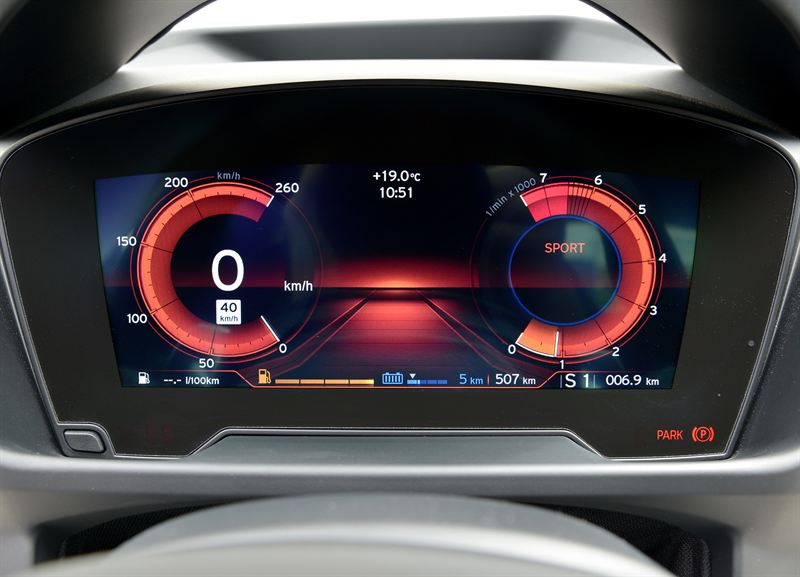Display-based instrument cluster in the BMW i8
- Sophisticated high-performance dual-processor architecture
- High flexibility when processing content
- Mineral glass pane over the display exudes quality


The instrument cluster represents a leap in technology, just like the vehicle itself: in the BMW i8, the driver is presented with display-based instrumentation. There are no mechanically moving parts whatsoever, and, thanks to the large monitor, the cluster provides a maximum in flexibility for processing and displaying content. It joins the car on its journey into a future that is increasingly shaped by driver assistance and infotainment systems and associated connectivity capabilities. Such a future therefore requires innovative display and control concepts.
The biggest advantage of a purely display-based instrument cluster is its versatility. It gives designers and developers complete freedom when devising the graphics and layout for the display area, thus leading to unprecedented design possibilities. Almost any conceivable shapes and colors can be utilised for a wide variety of operating states. The monitor furthermore allows specific navigation and online content to be presented to the driver clearly.
When designing the instrument cluster for this plug-in hybrid vehicle, the development engineers settled on a crystal-clear high-contrast TFT display with a diagonal screen size of 8.8 inches. The monitor is positioned in the driver’s field of vision and presents the vehicle’s current speed on the left, while the instrumentation on the right changes depending on which of the i8’s driving modes has been selected.
Encouraging economical driving
In ‘Comfort’ mode, the display shows a power meter on the right that indicates the energy utilisation on a dial, including the e-boost from the electric traction motor and the recuperation via the vehicle brakes. ‘Eco Pro’ mode is based on the ‘Comfort’ display but provides a more detailed representation of the transition states between the propulsion technologies, which can encourage the driver to adopt a particularly economical driving style. In both modes the basic dials are displayed in gray and blue tones. In contrast, ‘Sport’ mode presents two red instruments with a rev counter on the right, leaving no doubt of the i8 drive concept’s intrinsic power capabilities. In all modes, the space between the two sets of instruments is used flexibly to display, for example, navigation, radio or telephone information.
Perfect visual feedback
The sophistication of the instrument cluster for the BMW i8 required meticulous development work on the part of the Bosch engineers. An example of this can be seen in the exceptionally fluid motion of the pointers as they move over the dials. Both the hardware and software were carefully selected to guarantee the necessary performance for perfect visual feedback, even for highly dynamic animations.
This instrument cluster furthermore utilises a highly innovative dual-processor architecture, with one processing unit dedicated to handling the graphics and the other for the remaining functions. A level of computing power was chosen that additionally allows the electronics of a head-up display to be controlled via the instrument cluster. Data connectivity is provided by two bus systems: CAN (Controller Area Network) and MOST (Media Oriented Systems Transport).
The TFT display is covered with an optically bonded pane of mineral glass, just like the latest smartphones and tablet PCs, thus underscoring the cutting-edge design and modern look and feel of this instrument cluster.
For the BMW i8, Bosch also supplies various sensors, a gasoline direct injection system, starter motors, the power electronics for the starter generator, the front wiper system, and electric water pumps.
Contact: Susan Shrosbree, phone: 44 (0)1895 838545
Automotive Technology is the largest Bosch Group business sector. In 2013, its sales came to 30.6 billion euros, or 66 percent of total group sales. This makes the Bosch Group one of the leading automotive suppliers (NB: Due to a change in accounting policies, the 2013 figures can only be compared to a limited extent with the 2012 figures). Automotive Technology largely operates in the following areas: injection technology for internal-combustion engines, alternative powertrain concepts, efficient and networked powertrain peripherals, systems for active and passive driving safety, assistance and comfort functions, technology for user-friendly infotainment as well as car-to-car and Car2X communication, and concepts, technology, and service for the automotive aftermarket. Bosch has been responsible for important automotive innovations, such as electronic engine management, the ESP anti-skid system, and common-rail diesel technology.
The Bosch Group is a leading global supplier of technology and services. In 2013, its roughly 281,000 associates generated sales of 46.1 billion euros. (NB: Due to a change in accounting policies, the 2013 figures can only be compared to a limited extent with the 2012 figures). Its operations are divided into four business sectors: Automotive Technology, Industrial Technology, Consumer Goods, and Energy and Building Technology. The Bosch Group comprises Robert Bosch GmbH and its roughly 360 subsidiaries and regional companies in some 50 countries. If its sales and service partners are included, then Bosch is represented in roughly 150 countries. This worldwide development, manufacturing, and sales network is the foundation for further growth. In 2013, the Bosch Group invested some 4.5 billion euros in research and development and applied for some 5,000 patents. This is an average of 20 patents per day. The Bosch Group’s products and services are designed to fascinate, and to improve the quality of life by providing solutions which are both innovative and beneficial. In this way, the company offers technology worldwide that is “Invented for life.”
Additional information can be accessed at www.bosch.co.uk and www.bosch-press.com.
Follow us on Twitter/BoschUK and Facebook/BoschUK



